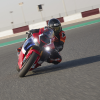
TWO of the most important adventure bikes of 2020 are the Honda CRF1100L Africa Twin and the Triumph Tiger 900 Rally Pro.
Both offer world-class electronics, real-world ability and more off-road ability than most riders will know what to do with. the pricing for the smaller of the two Africa Twins and the Tiger 900 Rally pro are also extremely close, making the decision of which to choose even more tricky!
We've been lucky enough to ride both the new and previous-gen' Africa Twins and have spent many miles on the Tiger 800 and 900. We've tested both bikes on and off-road at great length, and spent 1000s of miles pounding motorways to bring you the verdict on two of the freshest adventure motorcycles available today.
Pricing
The Honda CRF1100L Africa Twin – and not the Adventure Sports edition – is the focus of this comparison. There are two versions of the bike, DCT and manual. The manual bike comes in at £13,049 and the DCT is £13,949. On 4000-miles P/A and a £2,793.23 deposit, the Honda comes back at 36 monthly payments £165. So, that’s for the non DCT bike with no accessories added.
The Triumph Tiger 900 Rally Pro is the most off-road focused of the five bikes in the Tiger 900 range. It comes in at £13,100. On the same deposit and mileage as the Honda, the Triumph is showing a monthly price of £151.12 over 36-months.
Engine
Both bikes feature heavily revised engines for 2020, with Honda going for a capacity and power increase and Triumph opting for the innovative T-plane crank design in its quest for a more rugged engine character.
First off, let's look at the Honda and the new 1100cc parallel twin-cylinder unit. Producing 101hp and 77ft-lbs of torque, the Africa Twin is a fairly easy-going and dependable unit that only really becomes boisterous if you give it a serious poke with a stick.
It’s almost typically Honda in its delivery, offering a wide spread of easy to access torque throughout the rev range. It’s backed by a silky-smooth ride-by-wire throttle that makes town riding and B-roads a doddle.
On the motorway it’s smooth and well mannered, cruising at 70mph will see the engine under 4,000rpm while delivering between 60 and 70 vibration-free mpg.
Once you hit the dirt and get the bike set into a more off-road inclined riding mode, the 270° crank of the Africa Twin’s engine really comes into its own, pulsing more like a V-twin and giving the rear tyre some precious time to try and find some grip. I’d liken riding the Africa Twin off-road to hooning around on a dirty-great enduro machine. You can almost forget you’re actually riding a 226kg adventure bike and just focus on the task in hand.
The engine of the Tiger 900 not only has a capacity hike for 2020, but it also features what is believed to be the first time this type of crank arrangement has been used on a motorcycle. Triumph calls it the T-plane crank and it spaces the crankpins in such a way that the pulses from the 93bhp triple are now unevenly spaced. It gives the new machine a distinctive, rough and ready soundtrack as well as helping the rear tyre to hook up more on dusty and slippery surfaces.
Having ridden both the 800 and 900 Tiger variants on their respective Moroccan launches, I can testify that the system is very much more than just a marketing gimmick. The old, 800cc, non-T-plane engine, could spin up the back wheel at the drop of a hat. Great for drifting around and having fun, not so good when you were trying to navigate a tight, technical off-road section. The new engine’s distinctive deliver gives you a two-for-one character, with the engine behaving like a twin below 4000rpm and more like a triple above that.
The new delivery does have a drawback though; it is a little bit vibey at motorway speeds, with a thrumming running through the frame. It’s not massively so, especially when compared to other adventure bikes, but comparing it to the buttery-smoothness of the 800cc Tiger… it does feel a bit more rugged!
Electronics
As with the pricing and engines of these two bikes, they’re equally well-matched on the electronics front, with both having a full suite of on and off-road inclined goodies to play with.
Both bikes also feature class-leading TFT screens, with Honda’s touchscreen device and the Triumph’s very large, very clear and easy to read bonded TFT.
Beyond the headline-grabbing tech, both bikes feature IMU controlled traction control and ABS, customisable riding modes including a dedicated off-road mode.
I could go on at length about the pros and cons of each bike’s systems both on and off-road, but they’re both so advanced and well set up, it’s actually very hard to pick between them. Both will flatter a less experienced rider, allowing them to get away with things they’ve probably never done on a motorcycle before. They also offer enough adaptation through the electronics for more experienced riders to tailor the riding experience just how they like it.
If anything would sway me one way or the other on this, it’d be that the Triumph has a much easier to use rider interface, while the Africa Twin’s switchcube is… well, it’s a bit of a mess. You can use the touch screen TFT but doing that on the fly is distracting and means you have to take your hands off the bars.
The Triumph system though is a simple five-direction joystick that controls everything from riding modes to cancelling warning messages on the dash. It’s a much cleaner, simpler and better solution.
Verdict
With both these machines offering riders the ability to cover huge miles both on and off-road, choosing between the two is a very tricky task. They are matched on almost every level, from price, electronics, equipment and spec. For many, the choice will simply come down to brand loyalty.
For me, it comes down to application and where, when and how I would plan to use them. If I was looking for a do-it-all bike that would be used primarily as a day-to-day machine with some off-road work thrown in for good measure, I’d take a punt on the Africa Twin. It’s slightly roomier, has a bigger and slightly more padded pillion perch and will return slightly better MPG than the more revvy Tiger.
If I wanted a bike that would be more of an off-road workhorse and less of a mile-munching on-road machine though, I’d have to take the Tiger 900. It’s T-plane engine makes so much sense on the dirt and I’ve never felt as at home riding off-road as I did on the new Tiger 900.
The Tiger 900 is also slightly smaller in all directions than the Honda, helping it feel more agile, while still retaining that big-bike look and road presence.

